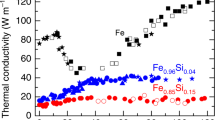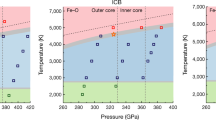Abstract
Geochemical, cosmochemical, geophysical, and mineral physics data suggest that iron (or iron–nickel alloy) is the main component of the Earth’s core1,2,3. The inconsistency between the density of pure iron at pressure and temperature conditions of the Earth’s core and seismological observations can be explained by the presence of light elements1,4. However, the low shear wave velocity and high Poisson’s ratio of the Earth’s core remain enigmatic2. Here we experimentally investigate the effect of carbon on the elastic properties of iron at high pressures and temperatures and report a high-pressure orthorhombic phase of iron carbide, Fe7C3. We determined the crystal structure of the material at ambient conditions and investigated its stability and behaviour at pressures up to 205 GPa and temperatures above 3,700 K using single-crystal and powder X-ray diffraction, Mössbauer spectroscopy, and nuclear inelastic scattering. Estimated shear wave and compressional wave velocities show that Fe7C3 exhibits a lower shear wave velocity than pure iron and a Poisson’s ratio similar to that of the Earth’s inner core. We suggest that carbon alloying significantly modifies the properties of iron at extreme conditions to approach the elastic behaviour of rubber. Thus, the presence of carbon may explain the anomalous elastic properties of the Earth’s core.
This is a preview of subscription content, access via your institution
Access options
Subscribe to this journal
Receive 12 print issues and online access
$259.00 per year
only $21.58 per issue
Buy this article
- Purchase on Springer Link
- Instant access to full article PDF
Prices may be subject to local taxes which are calculated during checkout




Similar content being viewed by others
References
Birch, F. Elasticity and constitution of the Earth’s interior. J. Geophys. Res. 57, 227–286 (1952).
Dziewonski, A. M. & Anderson, D. L. Preliminary reference Earth model. Phys. Earth Planet. Inter. 25, 297–356 (1981).
Dubrovinsky, L. S., Saxena, S. K., Tutti, F., Rekhi, S. & LeBehan, T. In situ X-Ray study of thermal expansion and phase transition of iron at multimegabar pressure. Phys. Rev. Lett. 84, 1720–1723 (2000).
Badro, J. et al. Effect of light elements on the sound velocities in solid iron: Implications for the composition of Earth’s core. Earth Planet. Sci. Lett. 254, 233–238 (2007).
Anderson, O. L. & Isaak, D. G. Another look at the core density deficit of Earth’s outer core. Phys. Earth Planet. Inter. 131, 19–27 (2002).
Dewaele, A. et al. Quasihydrostatic equation of state of iron above 2 Mbar. Phys. Rev. Lett. 97, 215504 (2006).
Antonangeli, D. et al. Composition of the Earth’s inner core from high-pressure sound velocity measurements in Fe–Ni–Si alloys. Earth Planet. Sci. Lett. 295, 292–296 (2010).
Mao, Z. et al. Sound velocities of Fe and Fe-Si alloy in the Earth’s core. Proc. Natl Acad. Sci. USA 109, 10239–10244 (2012).
Gubbins, D., Sreenivasan, B., Mound, J. & Rost, S. Melting of the Earth’s inner core. Nature 473, 361–363 (2011).
Mao, H. K. et al. Phonon density of states of iron up to 153 gigapascals. Science 292, 914–916 (2001).
Lin, J-F. et al. Sound velocities of iron–nickel and iron–silicon alloys at high pressures. Geophys. Res. Lett. 30, 2112 (2003).
Mao, W. L. et al. Nuclear resonant X-ray scattering of iron hydride at high pressure. Geophys. Res. Lett. 31, L15618 (2004).
Murphy, C. A., Jackson, J. M. & Sturhahn, W. Experimental constraints on the thermodynamics and sound velocities of hcp-Fe to core pressures. J. Geophys. Res. B 118, 1999–2016 (2013).
Shibazaki, Y. et al. Sound velocity measurements in dhcp-FeH up to 70 GPa with inelastic X-ray scattering: Implications for the composition of the Earth’s core. Earth Planet. Sci. Lett. 313–314, 79–85 (2012).
Gao, L. et al. Pressure-induced magnetic transition and sound velocities of Fe3C: Implications for carbon in the Earth’s inner core. Geophys. Res. Lett. 35, 1–5 (2008).
Gao, L. et al. Effect of temperature on sound velocities of compressed Fe3C, a candidate component of the Earth’s inner core. Earth Planet. Sci. Lett. 309, 213–220 (2011).
Prescher, C. et al. Structurally hidden magnetic transitions in Fe3C at high pressures. Phys. Rev. B 85, 6–9 (2012).
Wood, B. J., Li, J. & Shahar, A. Carbon in the core: Its influence on the properties of core and mantle. Rev. Mineral Geochem. 75, 231–250 (2013).
Nakajima, Y., Takahashi, E., Suzuki, T. & Funakoshi, K. “Carbon in the core” revisited. Phys. Earth Planet. Inter. 174, 202–211 (2009).
Lord, O. T., Walter, M. J., Dasgupta, R., Walker, D. & Clark, S. M. Melting in the Fe–C system to 70 GPa. Earth Planet. Sci. Lett. 284, 157–167 (2009).
Mookherjee, M. et al. High-pressure behavior of iron carbide (Fe7C3) at inner core conditions. J. Geophys. Res. 116, B04201 (2011).
Chen, B. et al. Magneto-elastic coupling in compressed Fe7C3 supports carbon in Earth’s inner core. Geophys. Res. Lett. 39, 2–5 (2012).
Herbstein, F. H. & Snyman, J. A. Identification of Eckstrom–Adcock iron carbide as Fe7C3 . Inorg. Chem. 3, 894–896 (1964).
Fruchart, R. & Rouault, A. Sur l’existence de macles dans les carbures orthorhombiques isomorphes Cr7C3, Mn7C3, Fe7C3 . Ann. Chim. 4, 143–145 (1969).
Fornasini, M. L. & Merlo, F. Ca7Au3 and Ca5Au4, two structures closely related to the Th7Fe3 and Pu5Rh4 types. J. Solid State Chem. 59, 65–70 (1985).
Potapkin, V. et al. The 57Fe synchrotron Mössbauer source at the ESRF. J. Synchrotr. Radiat. 19, 559–569 (2012).
Chumakov, A. & Rüffer, R. Nuclear inelastic scattering. Hyperf. Interact. 113, 59–79 (1998).
Achterhold, K. et al. Vibrational dynamics of myoglobin determined by the phonon-assisted Mössbauer effect. Phys. Rev. E 65, 051916 (2002).
Lin, J-F et al. Sound velocities of hot dense iron: Birch’s law revisited. Science 308, 1892–1894 (2005).
Glazyrin, K. et al. Importance of correlation effects in hcp iron revealed by a pressure-induced electronic topological transition. Phys. Rev. Lett. 110, 117206 (2013).
Acknowledgements
Partial financial support was provided through the German Science Foundation (DFG), the German Ministry of Education and Research (BMBF), and the PROCOPE exchange programme. We acknowledge the European Synchrotron Radiation Facility for provision of synchrotron radiation facilities through both the normal user programme and a Long Term Project. Portions of this work were performed at GeoSoilEnviroCARS (Sector 13), Advanced Photon Source (APS), Argonne National Laboratory. GeoSoilEnviroCARS is supported by the National Science Foundation—Earth Sciences (EAR-1128799) and Department of Energy—Geosciences (DE-FG02-94ER14466). Use of the Advanced Photon Source was supported by the US Department of Energy, Office of Science, Office of Basic Energy Sciences, under Contract No. DE-AC02-06CH11357.
Author information
Authors and Affiliations
Contributions
M.M. and Y.N. synthesized the starting materials. E.B., K.G., N.D., L.D. and M.H. performed the SCXRD measurements. C.P., L.D., C.M., I.K., A.K., M.M., R.S., V.C., R.R. and A.C. performed the NIS measurements. C.P., L.D. and V.P. performed the high-pressure, high-temperature powder X-ray diffraction measurements. N.M. performed the TEM analysis of the recovered molten sample. C.P., L.D. K.G., I.K., A.K., A.C. and R.R. performed the SMS experiments. C.P., L.D., E.B. and C.M. performed the data analysis. C.P., L.D. and C.M. wrote the paper. All authors discussed the results and commented on the manuscript.
Corresponding author
Ethics declarations
Competing interests
The authors declare no competing financial interests.
Supplementary information
Supplementary Information
Supplementary Information (PDF 2478 kb)
Rights and permissions
About this article
Cite this article
Prescher, C., Dubrovinsky, L., Bykova, E. et al. High Poisson's ratio of Earth's inner core explained by carbon alloying. Nature Geosci 8, 220–223 (2015). https://doi.org/10.1038/ngeo2370
Received:
Accepted:
Published:
Issue Date:
DOI: https://doi.org/10.1038/ngeo2370
This article is cited by
-
Inner core composition paradox revealed by sound velocities of Fe and Fe-Si alloy
Nature Communications (2022)
-
Superionic iron alloys and their seismic velocities in Earth’s inner core
Nature (2022)
-
The Fe-FeSi phase diagram at Mercury’s core conditions
Nature Communications (2022)
-
Materials synthesis at terapascal static pressures
Nature (2022)
-
Sound velocity of hexagonal close-packed iron to the Earth’s inner core pressure
Nature Communications (2022)



